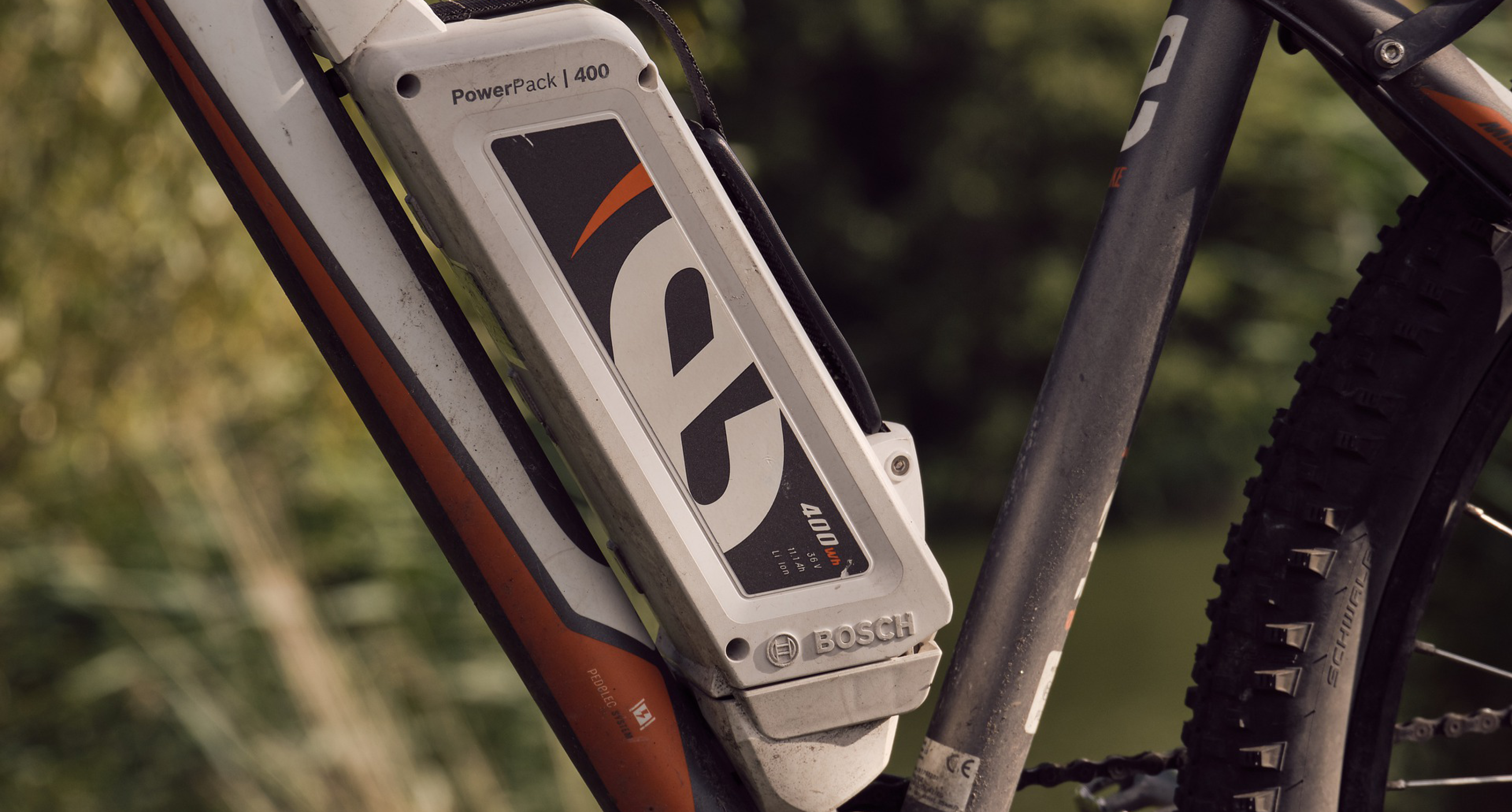How do you choose the right electric bike? Advice from battery experts!
Of the 29%* of the population who want to buy a new bike, 79% opt for a new model. Doctibike shares its advice to help you find your way around. Our aim? To help you make the right choice, because electric bikes are one of the best ways to get around town!
What is an electric bike ?
Electric city bikes, electric mountain bikes, electric mountain bikes and electric folding bikes make up the large family of electrically-assisted bikes. Let's take a look at the 4 key electrical components of these 2-wheelers.
- The motor
Bear in mind the difference between a power-assisted bike (which assists pedalling), a fully electric bike (such as a Moovway) or an electric scooter, where all you have to do is press a button to move forward.
- The controller
Also known as a variator, the controller is the brains behind the bike's motorisation. This electronic motor management unit receives information from the sensor installed in the crankset or accelerator handle to regulate the motor's power. It also manages the light, display and other elements that make up your electric bike.
- The display / control
The displays on electric bikes are either LED or LCD. Depending on the model, they can be used to control your level of assistance, turn on the lights and indicate your battery charge level and speed. The most advanced bikes now have a USB port so you can recharge your smartphone while you're pedalling.
"We recommend KALKHOFF bikes, for example, which offer a wide range of displays.
- The battery
2 options: recharge the battery on the bike or remove it from the frame and charge it wherever you like (home, work, etc.).
"To maximise the life of a battery, you need to look after it properly. You need to recharge it regularly, even if it's not in use, and store it in a place that's not prone to wide variations in temperature".
How do you choose the right bike based on battery performance? Find out more below!
Want to find out more about EAB components? Read our article: The 6 components that make your electric bike go - Doctibike
What are the key criteria to consider when choosing an E-bike?

- Expected services
There's a wide range of electric bikes, so that each user can set off with their hair blowing in the wind, depending on what they're looking for: a velotaf, a multi-purpose bike for juggling weekday and weekend activities, a travel bike... Consider your main activity and usage constraints, and tell the sales staff you meet about them!
- Budget
Be wary of the low-priced bikes on offer in supermarkets. While the initial investment may be tempting, the annual maintenance costs, particularly in view of the availability of 1st price spare parts, can quickly confirm the adage that "the cheapest is always too expensive". Batteries are no exception to this rule either.
Whatever your budget, don't forget to maintain your bike regularly: grease the chain, change the brake pads, follow the battery maintenance advice, etc.
- Build quality and equipment, especially battery life
Bear in mind that a battery with too little capacity can become a handicap, as it decreases due to the natural wear and tear of its cells. Unless you're particularly vigilant about using the assistance and don't have many hills to climb, it's better to opt for a battery offering more than 300 Wh of energy, or even 400 Wh or more, to be sure of being able to cycle more than 20 km a day after a few months' use of the bike.
- The role of the battery
Electric bikes on the market today are systematically fitted with lithium batteries. Lighter and more efficient than previous battery technologies (lead and nickel cadmium), they come in all shapes and sizes, and can be fitted in the luggage rack, behind your seatpost, on your bottle cage or built directly into the frame of your electric bike.
The battery: an important criterion when choosing an electric bike!

What to look out for in an electric bike battery
- Voltage
The higher the voltage of a battery, the greater the feeling of power when riding. "We recommend avoiding less powerful 24V batteries, which are becoming increasingly rare on the market. Beware of the more expensive 48V batteries often used for electric scooters. The ideal solution is somewhere in between: 36V.
- Amperage
Voltage is usually 24, 36 or 48 volts. Their capacities, expressed in amperes per hour, influence the battery's range: the higher the amperage, the greater the range.
- The brand
Rely on feedback from the brands on the market. Well-established brands such as BOSCH, BMZ/BROSE, TRANZX and BH BIKES are guaranteed to grow with you over the years.
- The retailer
Make sure you choose the right dealer for your battery! There are some good batteries available on the unbranded products found mainly on bikes sold in supermarkets, but make sure you don't buy them from just anyone: "Exit Aliexpress, for example! See our advice in the article Electric bike battery: how to choose the right one?
As with any purchase, before choosing your battery: try to gather other customer opinions. You can also ask the retailer if they accept returns if you haven't found the right battery for you. Take advantage of the return conditions and guarantees (virtually non-existent at Aliexpress, for example).
At Doctibike, if a customer buys a battery and it doesn't work, a response will always be provided via the helpline or a network of shops, available to help out quickly. Buying a battery may seem easy, but installing it properly is sometimes difficult!
- Cell quality
Brands such as LG, PANASONIC and SAMSUNG are good brands of cells, offering a longer lifespan and more charge/discharge cycles.
Admittedly, buying cells from these brands represents a slightly more expensive investment, but you can be sure of getting a quality product. If this information is not specified, you can ask for it or check!
- Exchange and warranty conditions
A battery should last 5 years when used properly. At Doctibike, our products are guaranteed for 2 years. Make sure you observe the conditions of use to optimise this point!
- Technical characteristics of the battery
Its weight (lithium is lighter and more recent than lead), its capacity (Ah), its location (advantage of a battery in the frame: better weight distribution) and a lock on your battery should be observed. The latter helps to limit theft and avoid having to take it with you when you park.
- Spare parts, model date
Over the years, some parts, such as those on certain 2014 GIANT or BIONX electric bikes, have become inaccessible. So if you opt for a second-hand model, be careful about access to spare parts (batteries and battery components).
"Don't hesitate to consider the price of these spare parts: changing a BOSCH battery will cost you a lot more than changing one on a TOP LIFE bike. Similarly, if you have a key problem with your BOSCH battery, you'll have to replace the whole battery, whereas with DERBY CYCLE or KALKHOFF, all you have to do is overhaul the lock. It all depends on how you use your bike.
Doctibike's favourite batteries

As battery specialists, the Doctibike team shares its benchmarks:
- GIANT battery: easy to recondition, quality bike, responsive after-sales service
- BOSCH frame battery (active line) on KALKHOFF bikes, for example
Plus: can be installed anywhere by equipped professionals. The icing on the cake is that these batteries are compatible with more capacities.
- TRANZX battery on MATRA bikes: a pioneer in electric bikes, little known but renowned for their quality! Easily replaceable, spare parts available, low return rate....
- For fans of sport bikes: BH batteries and Yamaha batteries, with a plus for compatible Yamaha models.
What the Doctibike expert has to say about choosing an electric bike
"The right electric bike is the one that suits you! Before signing, it's essential to try out the bike. Go into a shop to get advice and test the bike that will become your travelling companion. 2 models with identical characteristics on paper may turn out to be completely different on the ground!
Few electric bike users master the battery technology that enables them to manage the energy storage unit in the best possible way. Rely on the expertise of professionals!
*Source : Union Sport & Cycle















